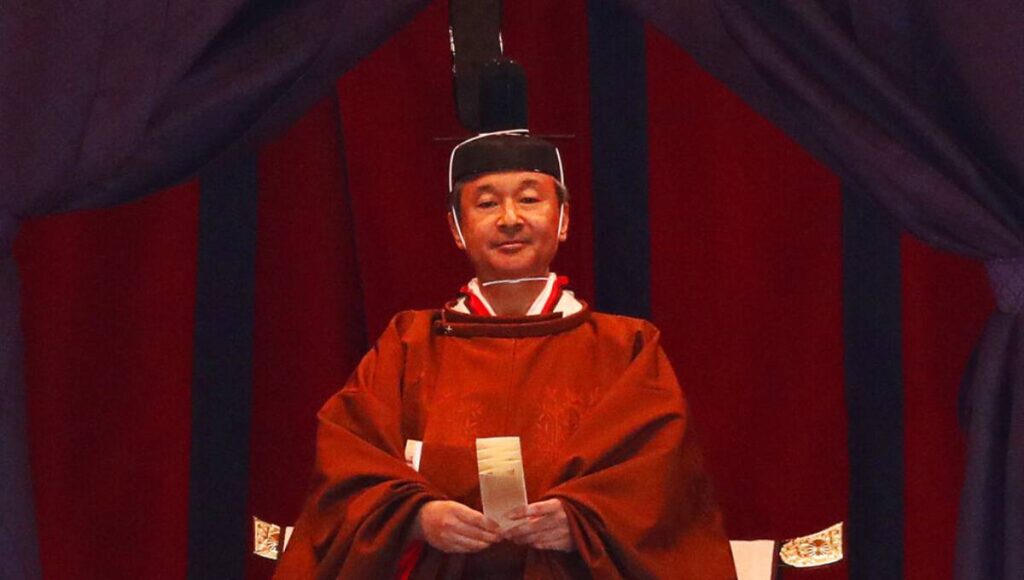Emperor Naruhito ascended the Chrysanthemum Throne on Tuesday, proclaiming himself Japan’s 126th emperor as the audience shouted “banzai” to wish him a long and prosperous reign.Naruhito pledged at an enthronement ceremony at the Imperial Palace to serve his constitutional duty as a symbol of the state and to stay close to the people, as Prime Minister Shinzo Abe congratulated him and led three “banzai” cheers. The cheers traditionally means “ten thousand year” of long life.
“I hearby proclaim to inside and outside of the country that I have enthroned,” Naruhito said as he stood inside the Imperial Throne. “I hereby swear that I will act according to the constitution and fulfill my responsibility as the symbol of the state and of the unity of the people of Japan, while always praying for the happiness of the people and the peace of the world as I always stand with the people.”
Naruhito, in a formal brownish-orange robe that has been dyed in sappanwood and Japanese wax tree bark and a black headdress decorated with an upright tail, appeared as a pair of black-robed chamberlains opened the purple curtains of the throne at the sound of a bell.
The throne, called “Takamikura,” is a 6.5-meter (21-foot) -high decorative structure resembling a gazebo or something at the Forbidden City in China. It was transported from the former Imperial Palace in Japan’s ancient capital of Kyoto, where emperors lived until 150 years ago.
The enthronement ceremony is the high point of several succession rituals that began in May when Naruhito inherited the throne after the abdication of Akihito, his father. Naruhito is the 126th emperor in the world’s oldest hereditary monarchy that historians say goes back 1,500 years.
The proclamation is largely meant to allow the government to showcase the monarchy to win public support and to preserve Japan’s cultural heritage, historians say.
Despite the time, effort and cost put into preparations, the ceremony lasted only about 30 minutes.
The enthronement ceremony was originally modeled after one by the ancient Tang dynasty of China and the second of a three-part process following the May succession. Next month sees the highly religious and divisive ritual of the Grand Harvest. Some experts have raised questions over the government’s funding of 16 billion yen ($150 million) for ceremonies that contain religious rites.
Criticism was largely eclipsed by the festive mood, in part because Naruhito’s succession was by abdication not by death, palace watchers said.
Abe’s ultra-conservative government also granted pardons marking the occasion. The decision was published Tuesday in the special edition of the official gazette, which provided for about 550,000 eligible applicants. The decision was not publicly debated.
The pre-war custom of clemency by the emperor has triggered criticism as being undemocratic and politically motivated. At the time of former emperor Akihito’s enthronement, 2.5 million people were given amnesty.
Earlier Tuesday, the 59-year-old emperor put on a white robe and prayed at “Kashikodokoro” and two other shrines. The visits Tuesday morning are to report to gods ahead of the ceremony, to be attended by 2,000 guests from in and outside Japan.
Enshrined at “Kashikodokoro” is the goddess Amaterasu, the mythological ancestress of Japan’s emperors.
Later Tuesday, Naruhito and his wife Masako, a Harvard-educated former diplomat, will host a court banquet, to be attended by about 400 foreign dignitaries and representatives from Japan’s administrative, legislative and judicial branches and their spouses.
A parade originally planned for Tuesday afternoon has been postponed until Nov. 10 due to a deadly typhoon that caused flooding and other damage in central and northern Japan.
Naruhito and Masako have been warmly welcomed by the Japanese public, despite comparisons to their beloved predecessors. They made positive impressions by freely conversing with U.S. President Donald Trump and first lady Melania during their visit weeks after Naruhito’s succession in May, palace watchers say.
“I think people have high expectations for the emperor who is fluent in foreign language and internationalized,” said historian and monarchy expert, Eiichi Miyashiro, also a journalist.
Naruhito is a historian, a viola player and an expert on water transport who studied at Oxford. Masako, a Harvard-educated diplomat, has struggled for more than a decade since developing “adjustment disorder” after giving birth to their only child, Princess Aiko, and facing pressure to produce a boy in Japan’s monarchy that only allows male heirs.
A shortage of males in the royal family has raised succession concerns. Naruhito has an 83-year-old uncle and two potential heirs — his younger brother Crown Prince Akishino and a 13-year-old nephew, prompting calls for a debate, possibly to allow female emperors.
Abe and his ultra-conservative supporters who want to keep paternalistic family values insist on male-only succession, while a majority of the general public support allowing female emperors, reports AP, Tokyo.




